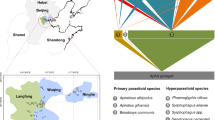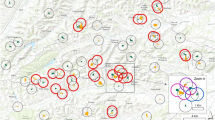Abstract
Human activity can degrade ecosystem function by reducing species number (richness)1,2,3,4 and by skewing the relative abundance of species (evenness)5,6,7. Conservation efforts often focus on restoring or maintaining species number8,9, reflecting the well-known impacts of richness on many ecological processes1,2,3,4. In contrast, the ecological effects of disrupted evenness have received far less attention7, and developing strategies for restoring evenness remains a conceptual challenge7. In farmlands, agricultural pest-management practices often lead to altered food web structure and communities dominated by a few common species, which together contribute to pest outbreaks6,7,10,11. Here we show that organic farming methods mitigate this ecological damage by promoting evenness among natural enemies. In field enclosures, very even communities of predator and pathogen biological control agents, typical of organic farms, exerted the strongest pest control and yielded the largest plants. In contrast, pest densities were high and plant biomass was low when enemy evenness was disrupted, as is typical under conventional management. Our results were independent of the numerically dominant predator or pathogen species, and so resulted from evenness itself. Moreover, evenness effects among natural enemy groups were independent and complementary. Our results strengthen the argument that rejuvenation of ecosystem function requires restoration of species evenness, rather than just richness. Organic farming potentially offers a means of returning functional evenness to ecosystems.
This is a preview of subscription content, access via your institution
Access options
Subscribe to this journal
Receive 51 print issues and online access
$199.00 per year
only $3.90 per issue
Buy this article
- Purchase on Springer Link
- Instant access to full article PDF
Prices may be subject to local taxes which are calculated during checkout



Similar content being viewed by others
References
Chapin, F. S. et al. Biotic control over the functioning of ecosystems. Science 277, 500–504 (1997)
Loreau, M. et al. Biodiversity and ecosystem functioning: current knowledge and future challenges. Science 294, 804–808 (2001)
Hooper, D. U. et al. Effects of biodiversity on ecosystem functioning: a consensus of current knowledge. Ecol. Monogr. 75, 3–35 (2005)
Cardinale, B. J. et al. Effects of biodiversity on the functioning of trophic groups and ecosystems. Nature 443, 989–992 (2006)
Chapin, F. S. III et al. Consequences of changing biodiversity. Nature 405, 234–242 (2000)
Matson, P. A., Parton, W. J., Power, A. G. & Swift, M. J. Agricultural intensification and ecosystem properties. Science 277, 504–509 (1997)
Hillebrand, H., Bennett, D. M. & Cadotte, M. W. Consequences of dominance: a review of evenness effects on local and regional ecosystem processes. Ecology 89, 1510–1520 (2008)
Srivastava, D. S. & Vellend, M. Biodiversity-ecosystem function research: is it relevant to conservation? Annu. Rev. Ecol. Evol. Syst. 36, 267–294 (2005)
Benayas, J. M. R., Newton, A. C., Diaz, A. & Bullock, J. M. Enhancement of biodiversity and ecosystem services by ecological restoration: a meta-analysis. Science 325, 1121–1124 (2009)
Tylianakis, J. M., Tscharntke, T. & Lewis, O. T. Habitat modification alters the structure of tropical host–parasitoid food webs. Nature 445, 202–205 (2007)
Macfadyen, S. et al. Do differences in food web structure between organic and conventional farms affect the ecosystem service of pest control? Ecol. Lett. 12, 229–238 (2009)
Wilsey, B. J. & Polley, H. W. Reductions in grassland species evenness increase dicot seedling invasion and spittle bug infestation. Ecol. Lett. 5, 676–684 (2002)
Wittebolle, L. et al. Initial community evenness favours functionality under selective stress. Nature 458, 623–626 (2009)
Bianchi, F. J. J. A., Booij, C. J. H. & Tscharntke, T. Sustainable pest regulation in agricultural landscapes: a review on landscape composition, biodiversity, and natural pest control. Proc. R. Soc. B 273, 1715–1727 (2006)
Losey, J. E. & Vaughan, M. The economic value of ecological services provided by insects. Bioscience 56, 311–323 (2006)
Landis, D. A., Gardiner, M. M., van der Werf, W. & Swinton, S. M. Increasing corn for biofuel production reduces biocontrol services in agricultural landscapes. Proc. Natl Acad. Sci. USA 105, 20552–20557 (2008)
Koss, A. M., Jensen, A. S., Schreiber, A., Pike, K. S. & Snyder, W. E. A comparison of predator and pest communities in Washington potato fields treated with broad-spectrum, selective or organic insecticides. Environ. Entomol. 34, 87–95 (2005)
Ramirez, R. A., Henderson, D. R., Riga, E., Lacey, L. A. & Snyder, W. E. Harmful effects of mustard bio-fumigants on entomopathogenic nematodes. Biol. Control 48, 147–154 (2009)
Ramirez, R. A. & Snyder, W. E. Scared sick? Predator-pathogen facilitation enhances exploitation of a shared resource. Ecology 90, 2832–2839 (2009)
Donnelly, A., Craigon, J., Black, C. R., Colls, J. J. & Landon, G. Elevated CO2 increases biomass and tuber yield in potato even at high ozone concentrations. New Phytol. 149, 265–274 (2001)
Finke, D. L. & Denno, R. F. Predator diversity dampens trophic cascades. Nature 429, 407–410 (2004)
Casula, P., Wilby, A. & Thomas, M. B. Understanding biodiversity effects on prey in multi-enemy systems. Ecol. Lett. 9, 995–1004 (2006)
Schmitz, O. J. Predator diversity and trophic interactions. Ecology 88, 2415–2426 (2007)
Letourneau, D. B. & Bothwell, S. G. Comparison of organic and conventional farms: challenging ecologists to make biodiversity functional. Front. Ecol. Environ 6, 430–438 (2008)
Bengtsson, J., Ahnström, J. & Weibull, A.-C. The effects of organic agriculture on biodiversity and abundance: a meta-analysis. J. Appl. Ecol. 42, 261–269 (2005)
Hole, D. G. et al. Does organic farming benefit biodiversity? Biol. Conserv. 122, 113–130 (2005)
Gitay, H., Wilson, J. B. & Lee, W. G. Species redundancy: a redundant concept? J. Ecol. 84, 121–124 (1996)
Yachi, S. & Loreau, M. Biodiversity and ecosystem productivity in a fluctuating environment: the insurance hypothesis. Proc. Natl Acad. Sci. USA 96, 1463–1468 (1999)
Silvertown, J., Dodd, M. E., Gowing, D. J. D. & Mountford, J. O. Hydrologically defined niches reveal a basis for species richness in plant communities. Nature 400, 61–63 (1999)
Finke, D. L. & Snyder, W. E. Niche partitioning increases resource exploitation by diverse communities. Science 321, 1488–1490 (2008)
Hedges, L. V., Gurevitch, J. & Curtis, P. S. The meta-analysis of response ratios in experimental ecology. Ecology 80, 1150–1156 (1999)
Kutner, M. H., Nachtsheim, C. J., Neter, J. & Li, W. Applied Linear Statistical Models (McGraw-Hill/Irwin, 2005)
Whittingham, M. J., Stephens, P. A., Bradbury, R. B. & Freckleton, R. P. Why do we still use stepwise modeling in ecology and behaviour? J. Anim. Ecol. 75, 1182–1189 (2006)
Acknowledgements
J. Owen and M. Thomas provided comments on the manuscript. G. Chang, R. Ramirez and A. Snyder provided survey data from potato fields. This project was supported by the National Research Initiative of the USDA National Institute of Food and Agriculture.
Author information
Authors and Affiliations
Contributions
D.W.C. and T.D.N. designed the field experiment, with contributions from W.E.S. and M.R.S. The field work was conducted by D.W.C. and the literature review was done by D.W.C. and T.D.N. The manuscript was written principally by D.W.C. and W.E.S., with input from T.D.N. and M.R.S.
Corresponding author
Ethics declarations
Competing interests
The authors declare no competing financial interests.
Supplementary information
Supplementary Information
This file contains Supplementary Tables S1-S8, References and Supplementary Figures S1-S5 with legends. (PDF 309 kb)
Rights and permissions
About this article
Cite this article
Crowder, D., Northfield, T., Strand, M. et al. Organic agriculture promotes evenness and natural pest control. Nature 466, 109–112 (2010). https://doi.org/10.1038/nature09183
Received:
Accepted:
Issue Date:
DOI: https://doi.org/10.1038/nature09183
This article is cited by
-
Integrating water and insect pest management in agriculture
Journal of Pest Science (2024)
-
Feeding experience on hairy vetch induces a loss of host-specific adaptation to maize and changes in the gut microbiota communities of the fall armyworm
Journal of Pest Science (2024)
-
Evaluation of augmentative biological control options against fruit and shoot borer, Conogethes punctiferalis (Guenée) (Lepidoptera: Crambidae) in guava in India
Egyptian Journal of Biological Pest Control (2023)
-
Effects of human activities on Sericinus montela and its host plant Aristolochia contorta
Scientific Reports (2023)
-
Initiatives for biodiversity conservation and utilization in crop protection: A strategy for sustainable crop production
Biodiversity and Conservation (2023)
Comments
By submitting a comment you agree to abide by our Terms and Community Guidelines. If you find something abusive or that does not comply with our terms or guidelines please flag it as inappropriate.



